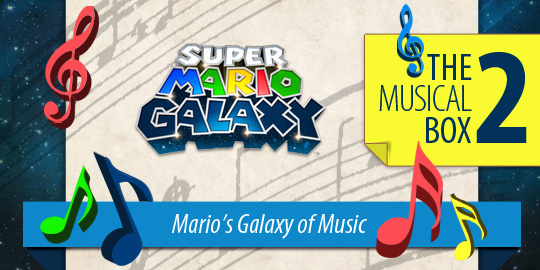The Musical Box #02: Mario's Galaxy of Music
The Musical Box features 30 articles focusing on game music production and implementation. Edition #2: Super Mario Galaxy 1 and 2


Super Mario Bros. is perhaps the most influential and famous videogame franchise ever created. Since 1985, when the first game was released for the NES, millions of people have played the role of the distinctive Italian plumber, jumping tirelessly through dangerous worlds and castles to ultimately save princess Peach from the hands of evil Bowser.
Mario games are considered by many in this industry as masterpieces, and they have raised the bar regarding many aspects of videogame creation, both technical and artistic.
The music is just one of the many highlights of this franchise. The “Overworld Theme”, composed by Koji Kondo for the original Super Mario Bros., is instantly recognizable by almost every gamer, and even those who are not interested in videogames. This song has also been performed by many groups, bands and even orchestras from all around the world.
The audio in Super Mario Bros. is not just beautifully crafted, it is also amazingly functional. Every single sound effect and piece of music is deeply connected to the gameplay, enhancing the experience in a very special way. There are countless examples of “dynamic” audio implementation in the franchise, but the objective of this edition of The Musical Box is to highlight two special moments from Super Mario Galaxy 1 and 2, released for the Wii in 2007 and 2010 respectively.
Special thanks to Rafael Martins (Sommastudio), Gilliard Lopes and Sandro Tomasetti for all the support.
The Set-up
The story of the game is the same since 1985: Peach is kidnapped by Bowser, and Mario must rescue her. In Super Mario Galaxy, our hero must travel to other planets and stars, each with its own distinctive style, in order to finally save princess Peach.
Because the game’s theme is very grandiose, the producers decided to hire an orchestra to play the music. This is the very first time orchestral music was recorded for a Mario game. The result is astonishing. Not only is the music beautiful and memorable, but it sounds big and “alive”. Of course, itis also perfectly connected to the gameplay.
The Moment
Both special moments of this edition of The Musical Box are arrangements of the classic tune from 1985, known as “Underground Theme”. In Super Mario Galaxy, there are stages in which you can collect colored notes. Each note collected corresponds to a tiny section of the famous aforementioned theme.
Most players will try to collect the notes as fast as they can, and the fact that there is such a classic tune tied to this action reinforces the feeling of urgency. As a gamer and musician, I felt compelled to collect the notes and not let the music be interrupted.
Check the video below:
The second memorable moment happens on “Beat Block Galaxy” in Super Mario Galaxy 2. The “Underground Theme” is synchronized with the gameplay of the entire stage. As the music plays, colored blocks are activated and deactivated, forcing the player to move fast in order to avoid falling. The music also signals the player when to jump. It reminded me of the “star of invincibility” in the first Super Mario Bros. game. You knew when the invincibility began and ended because the music communicated this information to you.
Check this moment at the location below:
The Impact
I was astonished when I heard the music of Super Mario Galaxy. It has the memorable melodies that have permeated the franchise since 1985 as well as fantastic orchestral arrangements. This is already reason enough to consider this soundtrack one of the best ever made in this industry.
When I noticed the clever audio implementation in several stages, this game quickly became my number one reference for “dynamic” music. Super Mario Galaxy’s soundtrack is the perfect marriage of musical knowledge and interactivity.
Do you have your own special musical moment from Super Mario Galaxy? Feel free to tell us about it on the comments section below!
Special thanks: Gilliard Lopes, Rafael Kuhnen, Fernando Secco, Sandro Tomasetti, and Rafael Martins (Sommastudio).
Read more about:
BlogsAbout the Author
You May Also Like









